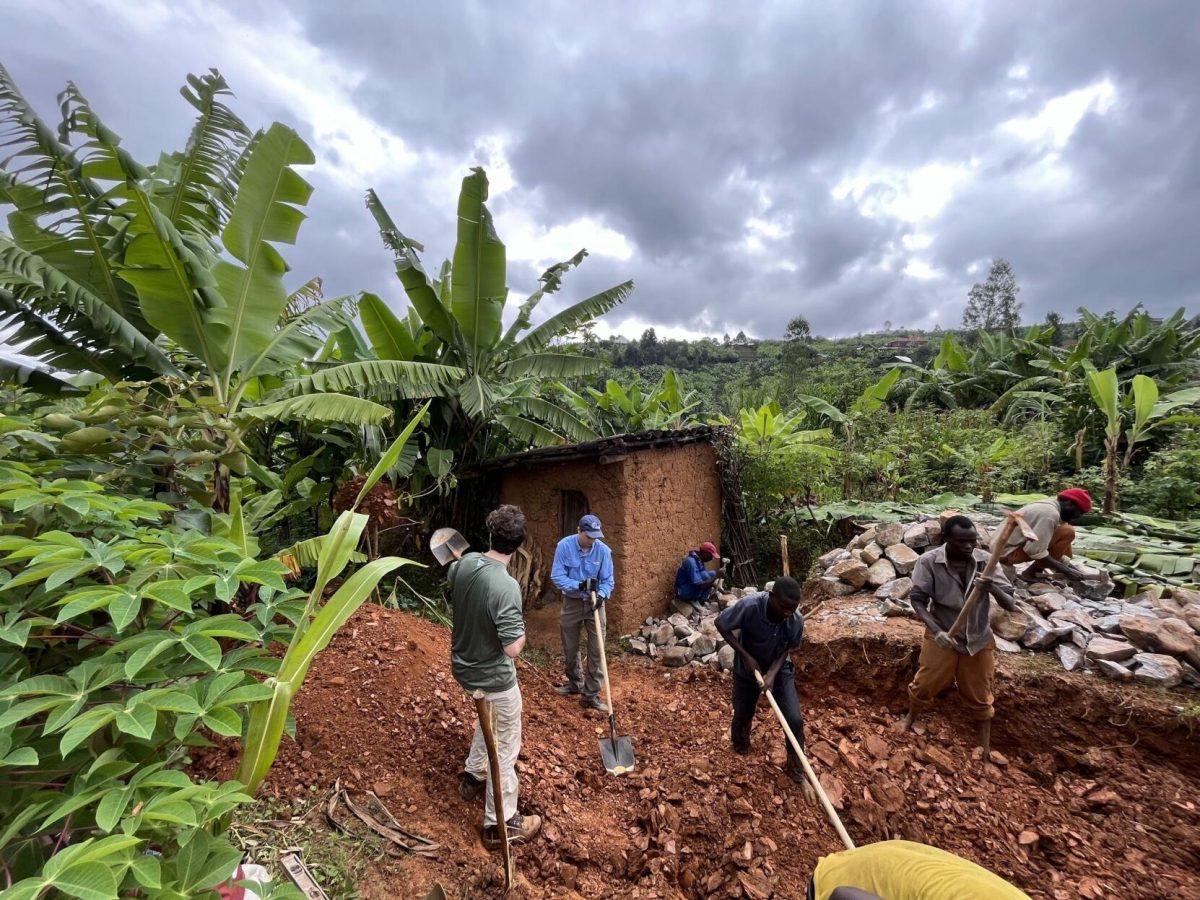On Nov. 15, the United Nations declared that the eight-billionth person had been born. Unbeknownst to most Aggies, the man who had done much to pave the way for that figure called Texas A&M home. Norman E. Borlaug, Ph.D., saved about a billion lives by breeding and distributing stronger varieties of wheat in the mid-twentieth century before teaching at A&M until his death in 2009.
Borlaug was born in the rural community of Cresco, Iowa, and spent his youth working on his family’s farm. Educated in a one-classroom school, Borlaug was prepared to head to what is now the University of Northern Iowa to become a teacher before a friend, who was headed to the University of Minnesota to play football, convinced Borlaug to follow him to the Twin Cities.
“[Borlaug] already signed up to go to Iowa State Teachers College, or whatever it was called back then, but his friend from the University of Minnesota that was playing football there came and said, ‘Come on Norm, go to Minnesota,’” Jeanie Laube, Borlaug’s daughter and a retired teacher in Dallas, said. “So he got there. And he didn’t have any money. And he didn’t pass the entrance exam. So they had to put him in a junior college, and of course, he said, you know, ‘I’ll get out of here.’ And he did, of course.”
While Borlaug would gain recognition for his accomplishments in agriculture, he is also remembered in Minnesota for being the founding father of wrestling in the state. Borlaug, an avid high-school wrestler, was surprised to find there was no wrestling team at the University of Minnesota and persuaded his high-school coach Dave Barthelma to come with him to form one. Barthelma would go on to introduce wrestling to high schools throughout the state.
Ken Quinn, former U.S. Ambassador to Cambodia, said Borlaug’s experience wrestling gave him the perseverance that would later help him during his agricultural career. A fellow Iowan, Quinn befriended Borlaug and later worked with him to establish the World Food Prize, recognized as the premier award in the world for accomplishments in agriculture.
“Norman Borlaug was a wrestler. He was a huge athlete, wrestled at the University of Minnesota. He’s in the National Wrestling Hall of Fame,” Quinn said. “He used wrestling as a metaphor for striving. He said, ‘You know, never let them pin down your shoulders, never give up, struggle.’ And he said that’s what sustained him through his years working in Mexico, where he never thought he was going to succeed.”
In 1938, Borlaug attended a lecture by Elvin Stakman, Ph.D., at Minnesota, who was discussing his research on breeding varieties of wheat that were resistant to a fungal disease known as rust. Borlaug, due to his childhood on an Iowa farm, was deeply familiar with the ability of rust to devastate wheat yields. He was intrigued by Stakman’s work and the potential of science to improve the lives of farmers. Borlaug switched his focus from forestry to agriculture, and upon his graduation from Minnesota with a Ph.D. in plant pathology and genetics, was employed by DuPont as a microbiologist.
At DuPont, Borlaug quickly became regarded as one of the leading experts in fertilizers and pesticides in the country. After the Japanese attack on Pearl Harbor, Borlaug rushed to enlist in the United States Army, but was turned away by the United States government, which wanted him to develop technologies at his lab at DuPont to support the war effort. Some efforts his lab was tasked with included glue that remained insoluble in warm Pacific saltwater and insecticides for malaria-carrying mosquitoes.
Following the conclusion of World War II, the administration of Mexican president Manuel Avila Camacho reached out to the Rockefeller Foundation to seek support from the United States for improving its agricultural sector to support its rapid industrialization. The Rockefeller Foundation recruited Borlaug out of DuPont to lead the new wheat improvement program headquartered in Mexico City, known as CIMMYT in its Spanish-language acronym.
“When I think about whether it is possible to achieve the type of urgent, big changes needed to meet today’s crises, I’m reminded of Dr. Norman Borlaug, who worked at The Rockefeller Foundation for more than four decades and helped the world feed hundreds of millions of people,” Raj Shah, current president of the Rockefeller Foundation, said. “In that time, Norman did everything he could to ensure new scientific advances like dwarf wheat reached those who needed them most.”
For 16 years, Borlaug worked in Mexico, developing better varieties of wheat by manually breeding plants with favorable traits. He was aided by his then-doctoral student Ronnie Coffman, Ph.D., who today is a professor emeritus of plant breeding and genetics at Cornell University.
Most prior research in improving the traits of wheat for harvesting, such as Stakman’s work, lied in improving hardiness and resistance to disease, as well as increasing the amount of edible wheat yielded from a single plant. While Borlaug’s team continued to work to improve these qualities, the innovation that made the Mexico City team’s wheat so much more effective than those that came before was shortening the length of the stalks.
“In addition to the disease resistance, Borlaug brought in the short-statured plant type. [The issue with increasing the edible yield of wheat] is lodging, or when the crop falls over,” Coffman said. “You get a larger head on [the plant], but it’s a tall stem. So you get a larger head and the plant is unbalanced and falls over. It’s hard to harvest and the grains are damaged. But with the short-statured plants, they would stand, and with a shorter stem you even get a stiffer, stronger straw.”
The wheat strains Borlaug’s team had developed, as well as his efforts to persuade farmers across Mexico to grow them, became extraordinarily successful. By 1963, 95% of Mexico’s wheat production consisted of the semi-dwarf strain that he had bred, resulting in a wheat harvest six times more plentiful than what it had been in 1944, the year Borlaug had arrived in Mexico. Around the same time, however, the exploding population in India and Pakistan as well as drought conditions had led to famine in the region.
Keerti Rathore, Ph.D., a crop science professor at A&M, was personally affected by Borlaug’s work before meeting him at A&M. Rathore recalled the effects of starvation that he witnessed growing up in India.
“When I grew up in India, I always saw beggars on the street. They were just sitting down and begging for food or money, and their legs were gone,” Rathore said. “They had been eating a kind of bean, the botanical name is Lathyrus, that farmers would grow if all the regular crops failed. Because it’s a very hardy crop, it will grow under any kind of stressful conditions. People were so desperate for any kind of protein in their diet that they would eat that bean. But this bean also has a very powerful neurotoxin, and if you eat it for a length of time, maybe a month or two, it paralyzes you below the waist.”
Borlaug believed the wheat strains he had developed could be of help, and convinced the Rockefeller Foundation to send him to the region. His effort to introduce his wheat strains to South Asia did not come without challenges. Conflicts with customs officials delayed his shipment of seeds from Mexico to the United States. The Watts Rebellion in Los Angeles then stalled the shipment from the United States to Asia. By the time Borlaug’s wheat finally arrived in India and Pakistan, the two nations had gone to war with each other.
“I went to bed thinking the problem was, at last, solved,” Borlaug was quoted saying in The Atlantic, “And woke up to the news that war had broken out between India and Pakistan.”
Nonetheless, Borlaug continued to work to implement his new wheat varieties in India and Pakistan. Aided by Indian scientist M.S. Swaminathan, Ph.D., Borlaug and his team worked with government officials and small farmers, often amid artillery fire, to plant the improved wheat strains.
Despite the difficulties that he faced, Borlaug’s efforts ultimately led to cereal yields in the Indian subcontinent nearly doubling within five years after his arrival. Food production in India and Pakistan outpaced population growth, and the explosion in agricultural productivity, termed the Green Revolution, is credited with averting mass starvation in the region.
“Dr. Borlaug’s impact on India’s science and economy went much beyond the Green Revolution. A science-based approach to the problems of agriculture was a fundamental tenet of his thinking and the success of the Green Revolution spawned other successful interventions in areas such as animal husbandry, dairying and agriculture,” Manmohan Singh, then Prime Minister of India, said in 2009 after Borlaug’s death. “Borlaug’s life and achievements are testimony to the far-reaching contribution that one man’s towering intellect, persistence and scientific vision can make to human peace and progress.”
For his work, Borlaug was awarded the Nobel Peace Prize in 1970. In his acceptance speech, Borlaug said a future without hunger had not yet been guaranteed and called upon the world to continue his mission.
“Obviously, I am personally honored beyond all dreams by my election. But the obligations imposed by the honor are far greater than the honor itself, both as concerns me personally and also the army of hunger fighters in which I voluntarily enlisted a quarter of a century ago for a lifetime term,” Borlaug said during his speech. “I am acutely conscious of the fact that I am but one member of that vast army and so I want to share not only the present honor but also the future obligations with all my companions in arms, for the Green Revolution has not yet been won.”
Borlaug retired from his position in 1979, but remained in Mexico City as a consultant for CIMMYT. In 1984, Ed Runge, Ph.D., then the head of A&M’s Soil and Crop Sciences Department, invited Borlaug to work at A&M as a professor.
“First, he didn’t believe me. I was at Iowa State in Ames at a meeting and he was there as well, and I offered him a job, and he didn’t believe me,” Runge said. “Anyway, he accepted my offer and we had him in the department for 25 years. [I think what drew him to A&M was] one, we asked, and two is his kids were here.”
Borlaug, raised in Iowa, educated in Minnesota, and having worked across the globe, finally found a place to permanently call home. Borlaug would remain at A&M for the rest of his life. A consummate Aggie, Borlaug was such a fan of Aggie football former A&M president Elsa Murano recalled that in his advanced age he walked across the Kyle Field parking lot to see a game after his parking spot was taken.
“You would think that he would call someone and say, ‘This is Dr. Norman Borlaug, somebody has taken my spot,’” Murano said. “But the old man that he was, in his 90s, he didn’t say a word, drove out to wherever the heck, parked super far and walked in all the heat to the stadium. Somebody found out about it and told [then A&M president Robert Gates] about it. From that point on, Gates put campus police at his spot so nobody could steal it.”
More than sports, however, Borlaug’s favorite thing about A&M were the Aggies themselves.
“He loved it down there. He always said, and he would go to Cornell and he would go to all these different schools and speak when they asked him to,” Laube said. “He said out of all the students of anywhere he went, his favorites were the Aggies because everybody was so kind and down to earth.”
In addition to teaching at A&M, Borlaug spent his last years working with former President Jimmy Carter to expand the Green Revolution to Africa. The pair recruited Ruth Oniang’o, Ph.D., a nutrition scientist and at the time a member of Kenyan parliament, to help with their mission. Oniang’o currently leads the foundation that they established in Africa.
“They were not African, they were already in their twilight years, but they saw what was happening in Africa,” Oniang’o said. “They had hope. They had hope for Africa, for a better-fed Africa.”
In 2009, Borlaug died at his Dallas residence of non-Hodgkin’s lymphoma. His lifelong belief that societal progress started at the level of the small-scale agricultural producer was reflected in his last words.
“Take it to the farmer,” Laube recalls.
Borlaug’s legacy is being carried on by A&M. At A&M’s Borlaug Center for Southern Crop Improvement, scientists work to create new strains of plants that are better suited for human use just as Borlaug had done at CIMMYT. In the past, scientists at the center bred a variety of cotton that grew protein-rich seeds suitable for human consumption.
“Cotton seeds have glands that produce a toxin called gossypol, but if you can remove that toxin, the seed becomes edible, so you can actually eat the cottonseed. Breeders actually came up with a new type of cotton, a mutant that had no glands anywhere, so the seed was good enough for people to eat,” Rathore said. “In fact, I have a couple of cans here. Texas A&M asked volunteers to eat it, and they all liked the taste. Cotton seed is about 23% protein and about 21% oil, so it’s a good source of protein and fat.”
However, the lack of toxin glands caused cotton crops to be susceptible to being eaten by pests. At the Borlaug Center, Rathore currently uses genetic engineering technology to create cotton varieties that lack gossypol only in the seeds. Though he did not have access to such tools during his career, Borlaug became a staunch advocate for using genetic technology for agriculture.
“Now, it was a very good product, but farmers didn’t want to grow it because gossypol, in fact, protects the plant from insects, and some diseases. So these new plants were being attacked very heavily by insects,” Rathore said. “What we’ve done is we’ve silenced a gene, specifically in the seed, to eliminate this gossypol, but the rest of the plant still contains gossypol, so it’s still protected against insects and diseases.”
At the Borlaug Institute for International Agriculture, Murano, who now serves as director of the institute, works to expand agricultural technologies and techniques developed at A&M to developing nations. Specifically, the institute has worked to recover the Rwandan agricultural sector after the genocide in the 1990s.
“We went to Rwanda after the genocide was over. There was a new government and the U.S. government gave us funding to go there and help train their faculty at their universities about agriculture methods, so they could then start to train the farmers,” Murano said. “We decided, ‘No,’ these people need help quicker than that.”
Murano said the institute determined Rwanda had a climate and geography suitable for growing coffee and made an effort to bolster the production of coffee in the region.
“We noticed that coffee was an important crop for them. We got these women farmers because their husbands had been murdered, and taught them how to grow coffee, when to pick the cherries from the coffee tree, how to dry them and process them,” Murano said. “We got them the first buyer out of a company in Louisiana to bring the very first shipment of Rwandan coffee into the United States. It transformed their economy incredibly, to the point where Rwandan coffee is one of the best quality coffees in the world. [Today, Rwanda is] doing pretty well. It’s one of the most stable countries in Africa.”
Above all else, Borlaug is remembered by his peers as an unassuming man who did his work not in search of notoriety but out of a desire to improve lives. Never as wealthy or as famous as many other Nobel Peace Laureates, Borlaug was content to allow his work to speak for itself.
“When I go speak to students or to people about my dad, I always say he was five things. He was a scientist, obviously. He was a humanitarian. He was a mentor — he loved mentoring young people and scientists from all over the world, making scientists. He also, after he won the Nobel Peace Prize, was turned into a quiet politician,” Laube said. “But to me, and to my brother, he was just our dad. We didn’t even know until he got the Nobel Peace Prize that he did anything extraordinary. He’d come home and he’d go to work. He worked a lot, I mean, a lot. I always say, he didn’t belong to us, he belonged to the world.”


























